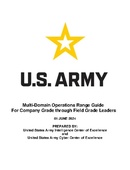
The Center for Army Lessons Learned leads the Army Lessons Learned Program and delivers timely and relevant information to resolve gaps, enhance readiness, and inform modernization.
| Unit: | Center for Army Lessons Learned |
| Latest Issue: | 08.22.2025 |
| Total Issues: | 58 |

This work, CALL Publications, must comply with the restrictions shown on https://www.dvidshub.net/about/copyright.

Downloads: 150
Hits: 150
The relationship between conventional and irregular warfare (IW) is often seen as a paradox, meaning that conventional warfare and IW appears contradictory...

Downloads: 275
Hits: 275
This guide addresses the critical need to enhance military training by incorporating realistic electromagnetic spectrum operations (EMSO) and intelligence...

Downloads: 201
Hits: 201
Task Force Gimlet implemented and tested the "Tactical Behavior Telehealth" (TBT) concept during its Joint Pacific Multinational readiness center (JPMRC)...

Downloads: 153
Hits: 153
First Army, Division East Observers, Coaches, Trainers (OC/Ts), and Advisors observed an Engineer Brigade during a WFX. They analyzed the brigade's...

Downloads: 190
Hits: 190
While the U.S. Army has divested itself from counterinsurgency doctrine, favoring instead large-scale combat operations in multi-domains, the...
| Unit: | Center for Army Lessons Learned |
| Latest Issue: | 08.22.2025 |
| Total Issues: | 58 |

This work, CALL Publications, must comply with the restrictions shown on https://www.dvidshub.net/about/copyright.